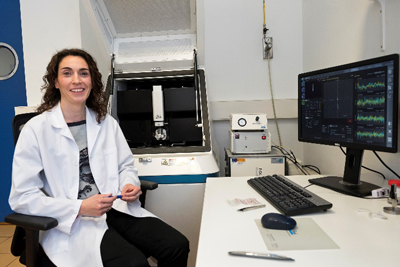
Fátima Linares Ordóñez at her Park NX20 AFM
Fátima Linares Ordóñez is currently a postdoctoral researcher at the Centro de Instrumentación Científica (Scientific Instrumentation Center, CIC) of the University of Granada, more specifically in the Atomic Force Microscopy devision, which she is responsible for. In addition, she collaborates with the group of Dr. Miguel Ángel Galindo Cuesta in the Department of Inorganic Chemistry (University of Granada). She earned her PhD in Chemistry from the University of Jaén in 2007. Fatima won a Research Grant of the Research Support Plan of the University of Jaén, which helped her to complete her Doctoral Thesis in the Department of Inorganic and Organic Chemistry of the University of Jaén, under the supervision of Professors M.N. Moreno Carretero and S.B. Jiménez Pulido. In January 2008, she joined the University of Granada as a postdoctoral researcher in the Department of Inorganic Chemistry, where she investigated the biosupramolecular chemistry of cyclic coordination/organometallic associations and the design and adsorptive properties of porous coordination polymers. Her teaching experience at the Pharmacy Faculty and Master´s Degree Program in Physics (Radiation, Nanotechnology, Particles and Astrophysics) at the University of rounds up her scientific expertise.
Her research activity has led to the publication of 14 research papers in leading scientific journals in the area of multidisciplinary chemistry, inorganic chemistry and materials: Angew. Chem. Int. Ed. (1), Chem Sci (1), J. Am. Chem. Soc. (1), Chem. Commun. (2), Inorg. Chem. (2), Cryst. Eng. Comm. (1), J. Inorg. Biochem. (1), Polyhedron (2), Acta Cryst. (2) and one in the drafting phase, with a total score of 411 citations and an H index of 8.
Fatima’s current research work is a part of research project titled “DNA molecules containing sequential metal-mediated base pairs for applications in nanoscience.” The project aims to develop new materials on a nanometric scale using synthetic DNA molecules and modifying them in order to enrich them with the electrical conductivity properties.
1.Please summarize the research you do and explain why it is significant?
The research that we have been working on in our research group is related to the development of new nanometer-scale materials using synthetic DNA molecules. Our goal is to modify their conductive and photoluminescent behavior and find their application in nanotechnology field. In this sense, our work focuses on the design, preparation and study of the properties of DNA molecules containing 1D metal array (metal-mediated base pairs). The high precision in preparation and controlling of these functional materials at the nanoscale plays here an essential role.
2.How might your research be used?
Nanowires may be applied in nanotechnology applications. The development of new strategies towards the fabrication of nanowires with tailored electronic and optical properties has been the subject of extensive efforts due to the practical applications they may offer for the miniaturization of electronic circuits. In order to design new nanocircuits the correct organization of the nanowires must be precisely controlled. In this context, DNA has become an important tool for scientists since intricate functional nanostructures can be prepared based on its sequence programmability. This reveals potential applications in nanomachinery, sensing devices, drug delivery, and information processing.
3.Why is the Park AFM important for your research?
For the type of materials, which we develop and which are based on the DNA molecule, the use of the Atomic Force Microscope is essential to characterize and evaluate the properties of these materials at the nanoscale. Park AFM is an essential tool in our work, easy to use and adapted to the requirements of investigated materials. Specifically, we work with the PARK NX20, a versatile system with a very intuitive software. In addition, we have the necessary modules to carry out measurements of conductivity, electrostatic force, magnetic and nanomechanical properties that complete the characterization of the samples’ topography.
4.What features of Park AFM are the most beneficial and why?
Park NX20, which we use for our research project, is not only available exclusively to our group, but it is located in the Scientific Instrumentation Center (CIC) of University of Granada, a center, which is open for different research groups at the University of Granada, as well as for other universities and interested companies. The accurate and reproducible measurements enabling better productivity, the accessible simple holder, the vertically aligned motorized Z stage and focus stage, the high speed Z scanner with 15 µm scan range and, last but not least, the expansion possibility for advanced SPM modes and options are essential characteristics in the daily work at an AFM system. The versatility offered by the NX20 system, as well as the easy tip exchange makes it an easy to operate and so, an easily accessible instrument to the scientific community of the university and other research centers and companies related to nanoscience.
For more information about the AFM research projects at the Scientific Instrumentation Center (CIC) go to:https://cic.ugr.es/servicios-y-unidades/ficha.php?codServicio=6&unidad=96
